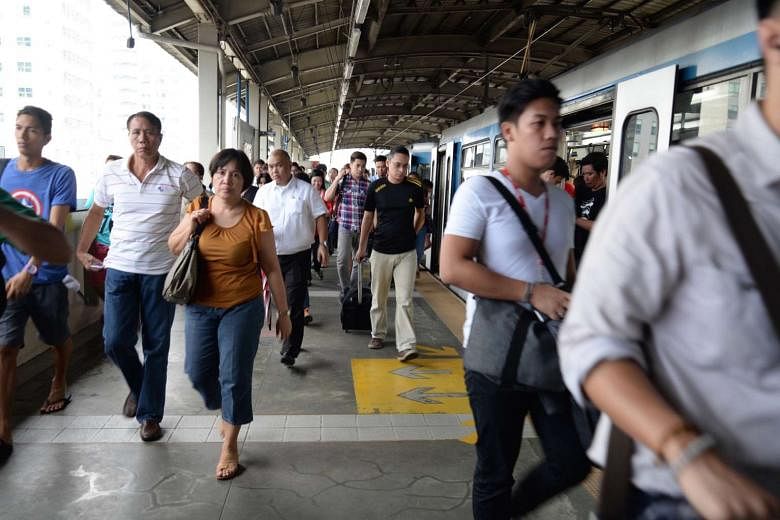By Cielito F. Habito
Philippine Daily Inquirer/Asia News Network
Businessman and long-time friend Gus de Leon recently posted on Facebook a lament we could all weep about: "Atraso ng DOTC sa mamamayan (DOTC's liabilities to the public)-airport mismanagement, slow Internet with no action for broadband and exchange infrastructure, light rail systems breakdown, Philippine National Railways inoperative, no drivers licence, no car plates, no stickers for registration, chaos in public land transport franchising…."
It's hard not to feel that the Department of Transportation and Communications has indeed been mishandling practically everything within its charge.
Fortunately, more positive news has been coming out of the other apex infrastructure agency, the Department of Public Works and Highways.
Still, one could well argue that even the development of our roads and highways has not proceeded fast enough. Increased economic activity and concomitant traffic volume growth have been proceeding faster than we can build the roads for it. We all see it in unbearable and worsening traffic congestion, and not just in Metro Manila.
As I argued last week, our infrastructure inadequacies now stand in the way of regaining and sustaining the high rates of economic growth we had already seen in recent years, until the disappointing slowdown early this year.
The problem, as anyone who travels the region has seen first hand, is that for many years, we've trailed behind most of our neighbours on practically the whole range of vital infrastructure facilities.
We ought to be working more than double time if we are to narrow and eventually close the gap. This is critical if we are to be competitive in attracting much-needed job creating investments, in which our record has been pathetic relative to our neighbours, notwithstanding recent record growth in our foreign direct investment inflows.
But here's the rub: even as government resolves to work double time on infrastructure, our neighbours are not exactly standing still; most of them are actually gearing up to move much faster as well. Alas, the faster we run, the more we may yet fall behind.
Malaysian Prime Minister Najib Razak puts key focus on infrastructure in implementing the 11th Malaysia Plan (11MP), their "last lap" in getting to former premier Mahathir Mohamad's Vision 2020, targeting developed nation status by then.
Information and communication technology (ICT) infrastructure is particularly prominent in Najib's new infrastructure initiatives in pursuit of 11MP. His government targets broadband infrastructure to reach 95 per cent of populated areas, while making broadband more affordable to all. Households in state capitals and "high-impact growth areas" will get 100 megabits per second (mbps) and rural areas will get 20-mbps broadband Internet connectivity.
Three years ago, ICT infrastructure in the public sector, previously managed by individual ministries, was consolidated into 1Gov*Net, a centrally-managed dedicated network connecting 10,552 out of 11,268 or nearly 94 per cent of all federal government buildings.
With its energy and transport infrastructure already world-class, Singapore, like Malaysia, is focused on ICT infrastructure as it pursues the aim of being the world's first smart nation. Government is installing a new platform encompassing the necessary infrastructure and technical architecture to support its "smart nation ecosystem," where everyone is ICT-enabled and "smart communities are driven by intelligence, integration, and innovation."
Thailand, for its part, is looking beyond its borders in planning its infrastructure development in the years ahead. It has embarked on an eight-year strategy and master plan for transport infrastructure development at a cost of $80 billion, aimed to turn Thailand into a key logistics hub in the Asean Economic Community by the time the projects are completed in 2022.
In Indonesia, accelerated infrastructure construction is President Joko Widodo's declared centerpiece economic program. He has been launching various high-visibility infrastructure projects such as toll roads, power generation plants, ports, factories, dams and bridges, and is pursuing a "Maritime Toll Way" to interconnect the Indonesian archipelago in a seamless logistics system. He has won unanimous parliamentary approval to expand direct government financing for infrastructure by 53 per cent.
Remarkably, the hiked infrastructure budget came at the cost of politically unpopular measures like ending fuel price subsidies, imposing new government charges, and mobilizing funds otherwise associated with insurance and health programs. It was a move that entailed tremendous political will from Widodo.
Back here at home, such political will has traditionally been a rare commodity in government, but when its lack of competence also gets in the way, then we're in real trouble. Average Internet speed is already reported to be slowest in the region at 3.7 mbps, even below Burma's (Myanmar), Laos', Cambodia's and Vietnam's, whose average speeds range from 5.1 to 18.5 mbps, based on a recent published comparison.
Our ICT office is struggling to institute its centralized iGov system similar to Malaysia's, but as a mere office within an executive department, it lacks the clout to stop individual agencies from insisting on procuring their own separate, often non-interconnectable systems.
So here we are, watching our closest neighbors further accelerate their infrastructure development and pull even farther ahead of us, while we watch our own facilities fall apart unless we do something fast.
Will someone please crack the whip so we can get our act together?

